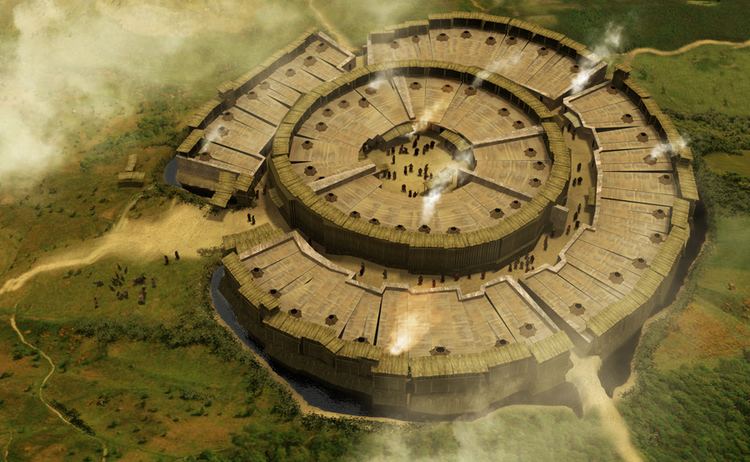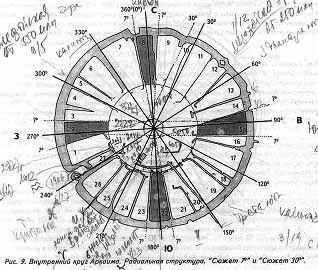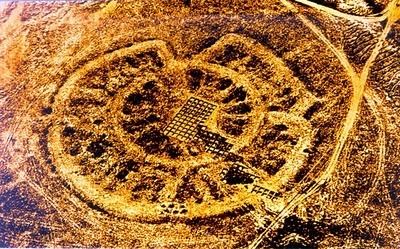Type Settlement Period Bronze Age | Area 2 ha (4.9 acres) | |
 | ||
Similar Stonehenge, National Park Taganay, Zyuratkul National Park, Iremel, Kapova Cave | ||
Arkaim russia s stonehenge and a puzzle of the ancient world
Arkaim (Russian: Аркаим) is an archaeological site situated in the Southern Ural steppe, 8.2 km (5.10 mi) north-to-northwest of the village of Amurskiy and 2.3 km (1.43 mi) south-to-southeast of the village of Alexandrovskiy, in the Chelyabinsk Oblast, just north of the Russian/Kazakhstan border.
Contents
- Arkaim russia s stonehenge and a puzzle of the ancient world
- Discovery and excavation
- Settlement
- In pseudoarchaeology and national mysticism
- Swastika City
- References

The site is generally dated to the 17th century BC. Earlier dates, up to the 20th century BC, have been proposed. It was a settlement of the Sintashta culture.

Discovery and excavation

The site was discovered in 1987 by a team of Chelyabinsk scientists who were preparing the area to be flooded in order to create a reservoir, and examined in rescue excavations led by Gennady Zdanovich. At first their findings were ignored by Soviet authorities, who planned to flood the site as they had flooded Sarkel earlier, but the attention attracted by news of the discovery forced the Soviet government to revoke its plans for flooding the area. It was designated a cultural reservation in 1991, and in May 2005 the site was visited by President Vladimir Putin.
Settlement

Although the settlement was burned and abandoned, much detail is preserved. Arkaim is similar in form but much better preserved than neighbouring Sintashta, where the earliest chariot was unearthed. The site was protected by two circular walls. There was a central square, surrounded by two circles of dwellings separated by a street. The settlement covered ca. 20,000 m2 (220,000 sq ft). The diameter of the enclosing wall was 160 m (520 ft). It was built from earth packed into timber frames, and reinforced with unburned clay brick, with a thickness of 4 to 5 m (13 to 16 ft). and a height of 5.5 m (18.04 ft). The settlement was surrounded with a 2 m (6 ft 7 in)-deep moat.

There are four entrances into the settlement through the outer and inner wall with the main entrance to the west. The dwellings were between 110 to 180 m2 (1,200 to 1,900 sq ft) in area. The outer ring of dwellings number 39 or 40, with entrances to a circular street in the middle of the settlement. The inner ring of dwellings number 27, arranged along the inner wall, with doors to the central square of 25 by 27 m (82 by 89 ft). The central street was drained by a covered channel. Zdanovich estimates that approximately 1,500 to 2,500 people could have lived in the settlement.

Surrounding Arkaim's walls, were arable fields, 130–140m by 45 m (430–460 ft by 150 ft), irrigated by a system of canals and ditches. Remains of millet and barley seeds were found.
The 17th century BC date suggests that the settlement was coeval with, or just after, the Indo-Aryan migration into South Asia and Mesopotamia (the Gandhara grave culture appearing in the Northern Pakistan from ca. 1600 BC, the Indo-European Mitanni rulers reached Anatolia before 1500 BC, both roughly 3,000 kilometres (1,900 mi) removed from the Sintashta-Petrovka area), and that it was either an early Iranian culture, or an unknown branch of Indo-Iranian that did not survive into historical times.
In pseudoarchaeology and national mysticism
Since its discovery, Arkaim has attracted public and media attention in Russia, from a broad range of the population, including a significant number of esoteric, New Age and pseudoscientific organizations.
One of the major researchers of Arkaim, Fyodor Petrov, acknowledged that he uncritically and non-scientifically supported the neopaganist views on Arkaim. His confession was published as an afterword to the book by Andrey Gupalo (Андрей Гупало «Духовное поле Аркаима»), which, in part, detailed how the archaeological results were "dovetailed" into the neopagan and esoteric theories.
A popular comedian, Mikhail Zadornov, made a pseudoscientific film, Arkaim. Standing by the Sun ("Аркаим. Стоящий у солнца"), in which data resembling earlier Zdanovich's documentaries of 1993 – The Fire of Arkaim ("Огонь Аркаима"), 1995 and 2005 were interpreted, mixed with anti-West ideas.
Swastika City
In order to gain publicity, the early investigators described Arkaim as "the ancient capital of early Aryan civilization, as described in the Avesta and Vedas", "Swastika City" and "Mandala City". The swastika description refers to the floor plan of the site, which (with some imagination) may appear similar to the swastika symbol, albeit with rounded arms (similar to the lauburu) attached to a central ring instead of a cross.
